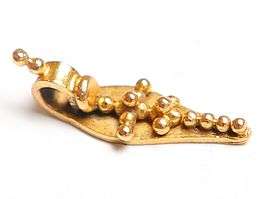Mangala sutra
A mangala sutra (from Sanskrit mangala, meaning 'holy, auspicious', and sutra, meaning 'thread') is a necklace that the groom ties around the bride's neck in Indian and sub-Indian countries, in a ceremony called Mangalya Dharanam (Sanskrit for "wearing the auspicious"), which identifies her as a married woman.[1]
This is a social practice widespread in India, Sri Lanka, and Nepal. This practice is also an integral part of a marriage ceremony as prescribed by Manusmriti.
Introduction
Mangala sutram literally means "an auspicious thread" which is knotted around the bride's neck. It is usually a necklace with black beads strung from a black or yellow thread prepared with turmeric. Sometimes gold, white or red beads are also added to the mangala sutram, depending on regional variation. It is a symbol of marriage worn by women. In certain communities, the groom ties the first knot while his sister tie the rest of the knots.
Significance
The significance of the mangala sutra was re-iterated by Adi Shankara in his famous book Soundarya Lahari. According to Hindu tradition, the mangala sutra is worn for the long life of the husband. Dictated by religious customs and social expectations, married women have to wear mangala sutra throughout their life as it is believed that the practice enhances the well-being of her husband.
Regional variations
It is called thaali (താലി) in Malayalam, mangal sutra (मंगळसूत्र) in Marathi, mangalyasutra (ಮಾಂಗಲ್ಯ), thaali (ತಾಳಿ) in Kannada, and thaali (తాళి), maangalyamu (మాంగళ్యము), mangalasutramu (మంగళసూత్రము) or pustelu (పుస్తెలు) in Telugu, thaali (தாலி), maangalyam (மாங்கல்யம்) in Tamil. Konkanis (Goans and others, both Hindus and Christians) wear three necklaces around their necks, referred to as dhaaremani or muhurtmani (big golden bead), mangalasutra with one or two gold discs and kasithaali with gold and coral beads. In Kerala, a Christian version of the mangalsutra is called a "minnu". In Andhra Pradesh and Telangana regions, the two coin-sized gold discs are separated by 2-3 beads of different kinds. By tradition, one disc comes from the bride's family and another from the groom's side.
Designs
Mangala sutras are made in a variety of designs. The common ones are the Lakshmi thaali, pustelu worn by the Telugus, ela thaali or minnu worn by the Malayalees and the kumbha thaali worn by the tamilians of the Kshatriya caste. The design is chosen by the groom's family according to prevalent customs. Gujaratis and Marwaris often use a diamond pendant in a gold chain which is merely ornamental in nature and is not a substitute to the mangala sutra in the traditional sense. Maharashtrians wear a pendant of two vati ornaments. The mangalya, thaali or mangala sutra of Kannidagas is similar to that of the Maharashtrians, except that it usually has two vatis. Nowadays many fashion conscious families opt for lighter versions, with a single vati or more contemporary style.
Gallery
 Traditional thali in Andhra Pradesh
Traditional thali in Andhra Pradesh Thaali with cross of 21 beads used by Saint Thomas Christians of Kerala.
Thaali with cross of 21 beads used by Saint Thomas Christians of Kerala. Pillayar Thali
Pillayar Thali Thamarai Thali
Thamarai Thali Thennaimarathali
Thennaimarathali Kongu Velalar thali
Kongu Velalar thali Vanniyar Thaali
Vanniyar Thaali
See also
References
- ↑ Subhamoy Das. "Mangalsutra Necklace - Hindu Symbol of Love & Marriage". About.com Religion & Spirituality. Archived from the original on 13 May 2016. Retrieved 8 May 2016.
Sources
- "An Ornament of Beauty," by Ganesh Joshi published in Woman's Era, January 2007.